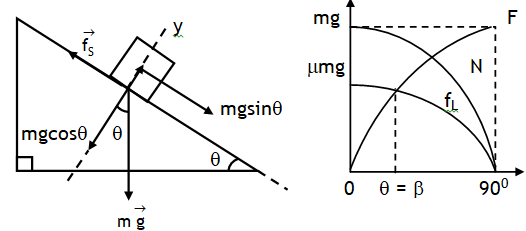^Motion on a rough inclined plane
^Motion on a rough inclined plane
Consider a body placed on a rough inclined plane.
The y component of the gravitational pull mg cosθ presses the plane & is balanced by normal reaction from the plane, thus N = mg cosθ.
The x component of the gravitational pull mg sinθ (say, F) tends to move the block down the plane, but can do so, only if it exceeds the limiting friction (fL = msmg cosθ) on the block.

As the inclination θ is increased mgsinθ increases while the limiting frictional force (mS mg cosθ) decreases. At one stage, mgsinθ & mS mg cosθ become equal & balance each other then the body placed of the inclined plane at the verge of motion. If the block at this stage is given some velocity it will keep sliding down at constant velocity.
This angle θ is called angle of repose & abbreviated by
symbol β. At θ = β,
or mg sin θ = mS mg cosθ
or tanβ = μS
Also we can make following conclusions
- If θ < β, then F < fL & block remains at rest. Friction on block is static & equals mg sinθ.
- If θ = β, then F = fL & block remains at rest. Friction on block is static & equals mg sinθ or msmg cosθ.
- If θ > β, then friction acting on the block is kinetic mK mg cosθ. This is less than mg sinθ & the block slides down the incline with a uniform acceleration. Using kinematic equations for UAM it can be checked that a block starting from rest will strike the ground with speed
 in time
in time  This is independent of mass of block.
This is independent of mass of block. - If the inclined plane is smooth (i.e. μ = 0), then the acceleration of a body sliding down a of inclination is, a = g sin θ
- Retardation by friction on a rough horizontal surface (i.e. θ = 00) is, a = μ g
- The force required to move the block up along the inclined plane with const. acceleration a is, F = mgsinθ + μmgcosθ + ma
